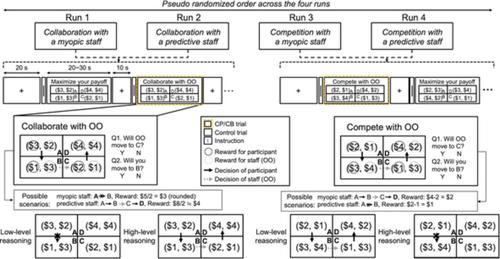当前位置:
X-MOL 学术
›
Hum. Brain Mapp.
›
论文详情
Our official English website, www.x-mol.net, welcomes your feedback! (Note: you will need to create a separate account there.)
Functional magnetic resonance imaging multivoxel pattern analysis reveals neuronal substrates for collaboration and competition with myopic and predictive strategic reasoning.
Human Brain Mapping ( IF 4.8 ) Pub Date : 2020-07-07 , DOI: 10.1002/hbm.25127 Dong-Youl Kim 1 , Eun Kyung Jung 1 , Jun Zhang 2 , Soo-Young Lee 3, 4 , Jong-Hwan Lee 1
Human Brain Mapping ( IF 4.8 ) Pub Date : 2020-07-07 , DOI: 10.1002/hbm.25127 Dong-Youl Kim 1 , Eun Kyung Jung 1 , Jun Zhang 2 , Soo-Young Lee 3, 4 , Jong-Hwan Lee 1
Affiliation

|
Competition and collaboration are strategies that can be used to optimize the outcomes of social interactions. Research into the neuronal substrates underlying these aspects of social behavior has been limited due to the difficulty in distinguishing complex activation via univariate analysis. Therefore, we employed multivoxel pattern analysis of functional magnetic resonance imaging to reveal the neuronal activations underlying competitive and collaborative processes when the collaborator/opponent used myopic/predictive reasoning. Twenty‐four healthy subjects participated in 2 × 2 matrix‐based sequential‐move games. Searchlight‐based multivoxel patterns were used as input for a support vector machine using nested cross‐validation to distinguish game conditions, and identified voxels were validated via the regression of the behavioral data with bootstrapping. The left anterior insula (accuracy = 78.5%) was associated with competition, and middle frontal gyrus (75.1%) was associated with predictive reasoning. The inferior/superior parietal lobules (84.8%) and middle frontal gyrus (84.7%) were associated with competition, particularly in trials with a predictive opponent. The visual/motor areas were related to response time as a proxy for visual attention and task difficulty. Our results suggest that multivoxel patterns better represent the neuronal substrates underlying the social cognition of collaboration and competition intermixed with myopic and predictive reasoning than do univariate features.
中文翻译:

功能性磁共振成像多体素模式分析揭示了与近视和预测性战略推理合作和竞争的神经元基质。
竞争和合作是可用于优化社交互动结果的策略。由于难以通过单变量分析区分复杂的激活,对社会行为这些方面背后的神经元基质的研究受到限制。因此,我们采用功能磁共振成像的多体素模式分析来揭示当合作者/对手使用近视/预测推理时竞争和协作过程的神经元激活。24 名健康受试者参加了 2 × 2 基于矩阵的顺序移动游戏。基于探照灯的多体素模式被用作支持向量机的输入,支持向量机使用嵌套交叉验证来区分游戏条件,并通过引导行为数据的回归验证识别的体素。左前岛叶(准确率 = 78.5%)与竞争相关,额中回(75.1%)与预测推理相关。下/上顶叶小叶 (84.8%) 和额中回 (84.7%) 与竞争相关,特别是在有预测对手的试验中。视觉/运动区域与响应时间相关,作为视觉注意力和任务难度的代表。我们的研究结果表明,多体素模式比单变量特征更能代表协作和竞争的社会认知与近视和预测推理相结合的神经元基质。额中回(75.1%)与预测推理相关。下/上顶叶小叶 (84.8%) 和额中回 (84.7%) 与竞争相关,特别是在有预测对手的试验中。视觉/运动区域与响应时间相关,作为视觉注意力和任务难度的代表。我们的研究结果表明,多体素模式比单变量特征更能代表协作和竞争的社会认知与近视和预测推理相结合的神经元基质。额中回(75.1%)与预测推理相关。下/上顶叶小叶 (84.8%) 和额中回 (84.7%) 与竞争相关,特别是在有预测对手的试验中。视觉/运动区域与响应时间相关,作为视觉注意力和任务难度的代表。我们的研究结果表明,多体素模式比单变量特征更能代表协作和竞争的社会认知与近视和预测推理相结合的神经元基质。视觉/运动区域与响应时间相关,作为视觉注意力和任务难度的代表。我们的研究结果表明,多体素模式比单变量特征更能代表协作和竞争的社会认知与近视和预测推理相结合的神经元基质。视觉/运动区域与响应时间相关,作为视觉注意力和任务难度的代表。我们的研究结果表明,多体素模式比单变量特征更能代表协作和竞争的社会认知与近视和预测推理相结合的神经元基质。
更新日期:2020-07-07
中文翻译:

功能性磁共振成像多体素模式分析揭示了与近视和预测性战略推理合作和竞争的神经元基质。
竞争和合作是可用于优化社交互动结果的策略。由于难以通过单变量分析区分复杂的激活,对社会行为这些方面背后的神经元基质的研究受到限制。因此,我们采用功能磁共振成像的多体素模式分析来揭示当合作者/对手使用近视/预测推理时竞争和协作过程的神经元激活。24 名健康受试者参加了 2 × 2 基于矩阵的顺序移动游戏。基于探照灯的多体素模式被用作支持向量机的输入,支持向量机使用嵌套交叉验证来区分游戏条件,并通过引导行为数据的回归验证识别的体素。左前岛叶(准确率 = 78.5%)与竞争相关,额中回(75.1%)与预测推理相关。下/上顶叶小叶 (84.8%) 和额中回 (84.7%) 与竞争相关,特别是在有预测对手的试验中。视觉/运动区域与响应时间相关,作为视觉注意力和任务难度的代表。我们的研究结果表明,多体素模式比单变量特征更能代表协作和竞争的社会认知与近视和预测推理相结合的神经元基质。额中回(75.1%)与预测推理相关。下/上顶叶小叶 (84.8%) 和额中回 (84.7%) 与竞争相关,特别是在有预测对手的试验中。视觉/运动区域与响应时间相关,作为视觉注意力和任务难度的代表。我们的研究结果表明,多体素模式比单变量特征更能代表协作和竞争的社会认知与近视和预测推理相结合的神经元基质。额中回(75.1%)与预测推理相关。下/上顶叶小叶 (84.8%) 和额中回 (84.7%) 与竞争相关,特别是在有预测对手的试验中。视觉/运动区域与响应时间相关,作为视觉注意力和任务难度的代表。我们的研究结果表明,多体素模式比单变量特征更能代表协作和竞争的社会认知与近视和预测推理相结合的神经元基质。视觉/运动区域与响应时间相关,作为视觉注意力和任务难度的代表。我们的研究结果表明,多体素模式比单变量特征更能代表协作和竞争的社会认知与近视和预测推理相结合的神经元基质。视觉/运动区域与响应时间相关,作为视觉注意力和任务难度的代表。我们的研究结果表明,多体素模式比单变量特征更能代表协作和竞争的社会认知与近视和预测推理相结合的神经元基质。


























 京公网安备 11010802027423号
京公网安备 11010802027423号